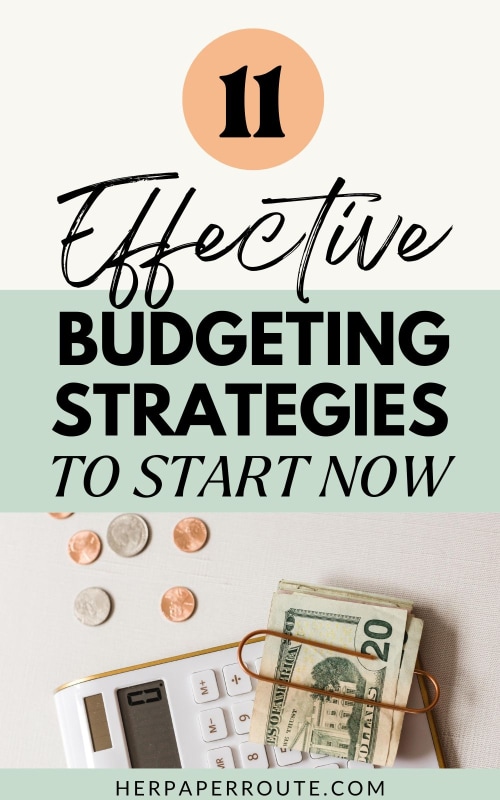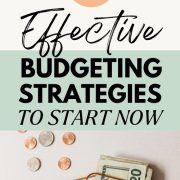11 Effective Budgeting Strategies To Start Implementing Right Now

You may be looking for suggestions on how to budget more effectively but maybe aren’t sure what budgeting strategies are still effective.
Budgeting and money management skills have become far too “lax” over recent years. This is largely due to the incorporation of buy-now-pay-later options and rapid cash loans.
As an affiliate partner of various brands and sponsored content, HerPaperRoute may earn commission on qualifying purchases. Disclaimer
This holds the potential to drive an individual further and further into debt. It also doesn’t allow a healthy relationship and understanding of money to be established.
With all this considered, why don’t many younger and more established people start implementing a solid budgeting strategy? Well, with all of the information out there, forming an effective budget seems easier than it actually is.
Classic Budgeting Techniques And Strategies That Still Work Today
I have been in your shoes and had to financially fall down in life to acquire the skills and knowledge I have now. I want to share this knowledge to you.
That’s why I have detailed these brilliant budgeting strategy tips that can help you get started today for a better tomorrow.
What’s The Benefit Of Implementing Effective Budgeting Strategies?
There are a variety of different advantages for making use of effective budgeting strategies. Here are some of the most common benefits:
- It puts the control of your money in your own hands.
- It helps to keep you focused on your financial goals.
- It keeps you on top of what you’re spending.
- It provides you with an easy way of staying aware of your savings and debts.
- It helps you save for unexpected costs.
- It shows you where your money issues are likely originating from.
Below I’ll cover all of the classic budgeting strategies and techniques that are still effective to use today.
1. Track Your Incoming And Outgoing Money
When looking to plan your budget, the first thing you’re going to need to look at is how much money you have coming in and where your money is going out to.
I always found that a month was the perfect length of time to budget for. Most people get two paychecks during this timeframe which helps split the month in half.
Your monthly expenses and income should be divided into two to fit this. Doing this ensures that you have enough money to make it through the month.
Far too often, people get their paychecks and spend their money like nobody’s business. The saying ‘you only live once’ doesn’t apply here as you still have another three weeks to live once you spend your entire month’s salary in one week.
You can plan these weekly revenue and expenditure streams with handy apps on your smartphone or keep it traditional with a record book and pen. This is an easy system for keeping track of your bills so you’re never late again.
I would also highly recommend using your bank statements and receipts as references when comparing your income and expenses. This ensures that the information you’re working with is as accurate as possible.
Want somewhere to track your money across all accounts? Grab this free financial dashboard to track your savings, retirement, net worth, and more!
2. Outline Your Budget
Once you have successfully identified your income and expenses for a pre-determined period, you can move on to writing out your budget outline. When doing this, you can split the costs into multiple categories, such as fixed expenses (mortgage or rent), essential groceries, entertainment, leisure, and utilities.
After you determine your spending projections, as previously discussed (weekly, fortnightly, or even monthly), you can now use these projections as a guide to understanding your outgoing spending for this particular time frame.
To learn more about setting up your budget, you can read about the best budgeting tips for beginners. It’ll go over the steps to use for setting up your budget, painlessly and quickly.
To help you make sure you’re optimizing your budget to the max, check out my free ebook below.

3. Save For Upcoming Expenses
It’s imperative that you plan to save for upcoming while implementing these budgeting strategies. One way to do this is by using sinking funds in your budget.
Sinking funds are small money goals for particular categories of spending, like birthdays and Christmas. Here’s a helpful list of common sinking funds that many people forget about.
To do this, you should decide on the amount of money you would like to put away and save from each paycheck. After deciding on this amount, you can start your savings strategy by having that money automatically entered set aside into a high-interest savings account.
It isn’t uncommon for people to look at their budget and come to the conclusion that they don’t have enough income to plan for sinking funds. I’ve been there, done that as well and regret the time I lost!
I still don’t know how I made it through some months where I barely knew anything about budgeting and used to spend all my money within the first few days of receiving my paycheck. Saving for known upcoming expenses was the last thing on my mind, and it was a huge, naïve mistake that I recommend you avoid.
If you don’t have room in your budget for sinking funds or aren’t saving enough to meet your objectives, I suggest checking through your budget to see where you can cut back on some things that may not be necessary.
4. Set Up A Savings Plan
Regularly adding to your savings is one of the most powerful things you can do to achieve your financial and lifestyle goals. Due to this, I highly recommend that you emphasize saving a portion of your salary each month.
When doing this, you should commit to saving a certain percent of your income. This could be 10, 20, or 30 percent of your salary each month.
Of course, you shouldn’t be breaking your back to try and save as much as possible. The goal of saving is to make it a sustainable activity.
Cutting out all costs for leisure or even some bare necessities is going to leave a bad taste in your mouth and associate saving with struggling, which isn’t the goal. Moreover, you’re likely to continue saving your money, even if it’s a small portion, each month while still living a little.
For example, saving 10 percent of your income each month and still having the funds to go out with friends occasionally and treating yourself is important. In contrast, you’re going to be more tempted to break your savings goal if you’re putting away 45 percent of your income and living on canned soup and instant noodles.
In addition to this, you should always have a purpose for your savings. This motivates you. The reasons for your savings could be for retirement planning, a big wedding, a vacation, or a new car.
5. Continually Review and Update Your Projections
Please learn from my mistakes and keep updating your budget. I am entirely guilty of letting my budget go out of date.
This ended in a complete disaster because I was spending money that wasn’t actually coming in. Plus, I didn’t realize that my expenses had gone up and couldn’t accommodate it.
To avoid this situation entirely, you can better prepare yourself by reviewing and updating the projections you have in your budget plan when your situation changes. These situations may include getting a raise at work, moving to a cheaper rental, leaving a part-time job, welcoming a new baby into the world.
Even if your budget doesn’t need a major overhaul, checking it over critically about once a month will help you see where you’re spending habits are changing and if anything needs to be done due to that.
An important rule to remember is that adjustments are always warranted in your budget when any aspect of your income and expenses change. You’re more likely to spend within your financial means and reach your goals by keeping your budget plan up to date.
6. Set Realistic Goals
No matter the goals you’re setting, it’s imperative that these goals are realistic in relation to your financial position. You’re likely going to notice a sudden disruption to your lifestyle when you try going from saving nothing to more than 50 percent of your pay in an instant.
This sudden change in lifestyle is more often than not going to be self-defeating.
In contrast, realistic goals are a lot more achievable. Not to mention, each time you reach a milestone, you’re going to be motivated to continue what you’re doing because you can see the fruits that these budget strategies are reaping.
7. Set New Goals
Remember that it’s important to continually set new goals as you achieve the objectives you’ve already set for yourself. Doing this provides you with something to always work towards achieving.
If you’d like some ideas on what money goals you should be setting, here are some examples.
You may have had a goal to save $10,000 as an emergency fund. After achieving this, you may decide that you want to save for a new car or a vacation.
This then drives you to continue saving for something else. You’re then able to maintain your budget and spend within your financial means.
Setting these new goals provides you with a guide that keeps you on your budget. As previously mentioned, this ensures that you spend within your financial means.
As a result of this, you’re less likely to take out debt to cover expenses that are going unpaid. This is because you’re planning your spending ahead and covering all of these costs.
8. Use the 50/20/30 Rule
Many people stray away from the idea of thoroughly budgeting their income and expenses. This usually stems from the percieved complexity that’s associated with budgeting.
For some, the idea of planning out a budget with long columns for different categories is just far too complicated to maintain.
Let’s face it! We don’t have time for that when we’re trying to run our household and work at the same time. That doesn’t distract from the fact that we do still need our finances in order.
That’s why making use of the 50/20/30 budgeting structure can be an absolute lifesaver. The breakdown of the 50/20/30 rule stipulates that you should be spending 50 percent of your incomings on necessities, putting away 20 percent of your incomings into a savings account, and 30 percent of your incomings should be spent on your lifestyle choices.
9. Try Out the Three-Category Budget
If you don’t particularly like the parameters of the 50/20/30 rule, there is another easy budgeting structure that you can try and implement into your financial spending. You can keep your budgeting relatively simple by using the three-category budget rule.
This rule entails that you simply choose and track three of the categories you’re most likely to overspend in. This is the alternative to monitoring every single cent that you spend.
An example would be that you may find yourself overspending on clothing, accessories, and eating out. If this is the case, you focus on tracking how much you’re spending on those categories and make sure you stay within your budget for them.
10. Use the Right Tools to Empower Yourself
In some cases, people plan their budgets only to fail because they don’t have the right tools. Planning and implementing budgeting strategies are complex mechanisms that don’t work as a one-size-fits-all.
As a result, what works for one may not work for the other. There’s no perfect solution for everyone.
That’s why it’s up to you to find the best tools that work for you. I used to work with a lot of cash in hand, which resulted in none of my transactions being recorded in bank statements. This made it really tricky for me to implement and track my budgeting strategies.
That’s when I discovered cash envelopes. I designed these for you – you can reprint them over and over again. They have a tracker right on the envelope so that you can record each purchase easily. Here’s a guide for using them.
This makes it easy to track where your money was going. This may not be your situation, but you may find similar solutions for you and your lifestyle.
11. Stay Motivated
It’s essential that you to understand that you’re the only person in charge of your finances. YOU are the one responsible for staying on track and staying motivated enough to follow your budget.
This is the budget you have established after following the above-listed budgeting strategies. The key to successfully implementing budgeting strategies is to celebrate your achievements and remind yourself regularly of the reasons you’re implementing these budgeting strategies.
You can do this by reviewing your goals, as this is going to bring to mind why sticking with these budgeting strategies is all worthwhile.
Effective Budgeting Strategies To Start Implementing Right Now – Conclusion
Making these budgeting strategies a part of your life is a set of tools that can help you achieve your wealth-building and lifestyle goals. It isn’t always easy, but the benefits gained from doing this are worthwhile.
Life throws you curveballs, and successfully keeping a budget and other classic techniques provides you with the ability to face these curveballs head-on.
Related Articles:

Follow along on Instagram!






![9 Best Types of Personal Budgets [How to Choose the Right One for You] 8 Hand writing in notebook about the Best Types of Personal Budgets](https://herpaperroute.com/wp-content/uploads/2021/11/Best-Types-of-Personal-Budgets-768x410.jpeg)



